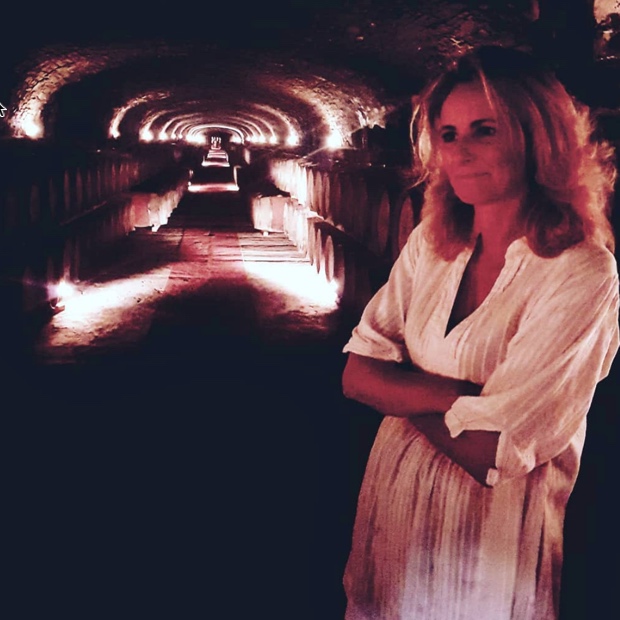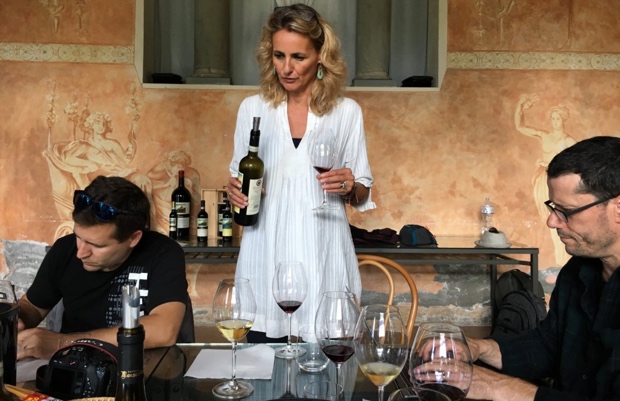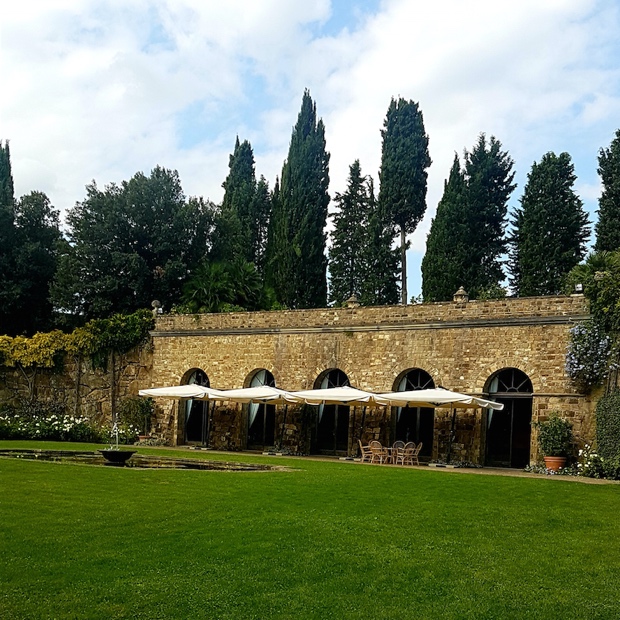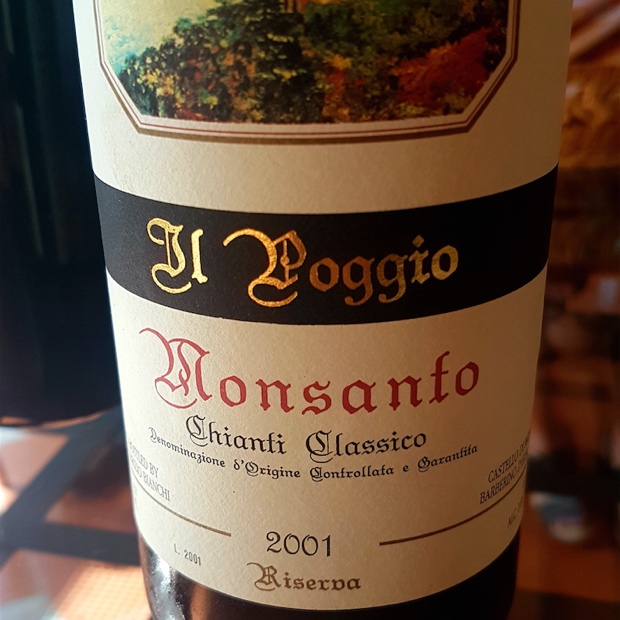Eternal. Abiding. Perennial. Permanent. Without end. All are synonyms that might be used to make connections, descry viewpoints or ascribe to ideas of timeless representation. Kinship in the name of Castello di Monsanto. In September of 2018 I step from of a plane in Firenze and one hour later find myself walking the caves with a greggi of Chianti Classico ambasciatori, led by the estate’s charge and enduring voice in Laura Bianchi.
Related – Chianti Classico’s Canadian dream
Monsanto’s story begins with Aldo Bianchi, a native of San Gimignano who arrives at the estate in 1960 and quickly purchases the property. His son Fabrizio and daughter in law Giuliana plant new vineyards, convert the numerous farmhouses and then, in 1962, for the first time within the area of the Chianti Classico denomination, Fabrizio vinifies grapes from Il Poggio vineyard. The birth of the Chianti Classico Cru.
In 1968, Fabrizio eliminates the white grapes trebbiano and malvasia from the Poggio blend, which at the time are a compulsory requirement for the specifications of the DOC and as a producer announces the message of putting sangiovese at the forefront. Then in 1974 the creation of the Fabrizio Bianchi Sangioveto, then labelled as Sangioveto Grosso – a table wine made exclusively from sangiovese grapes, from the 1968 Scanni vineyard. The same year 1974 the Valdigallo vineyard is planted, eventually leading to the Fabrizio Bianchi Chardonnay.
In 1986 the construction of underground caves begins. Mario Secci, Giotto Cicionesi and Romolo Bartalesi hand-build 300 metres of tunnels for the storing of wooden barrels, using only the Galestro marl stone from the vineyards, with the medieval technique of arched wooden ribs to give shape to a long and lowered Etruscan arch. In 1992 the work is completed.

Off the plane and into the catacombs with the effably endearing Laura Bianchi @castellomonsanto ~ #chianticlassico #bootcamp
Which brings us to Laura Bianchi. It is in 1989 that Laura begins to take part in the Monsanto work and since 2001 that she and Fabrizio have collaborated to take the company to where it is today. The six September wines poured by Laura Bianchi are the sort that bring so much of what Chianti Classico is to light. The most obvious sensory response is to sangiovese’s uncanny ability and drive to age with slow developing character and grace. The less knowable concerns the tenets of terroir and how each micro-block, hill and subset of soil will always deliver wines unlike any sister, brother, cousin or neighbour. Monsanto defines singularity and in turn the multiplicity of Chianti Classico. Timeless Castello Di Monsanto.

Chianti Classico Quebec ambassador Kler-Yann Bouteiller, Laura Bianchi and Godello — photo (c) Chianti Classico USA
Castello Di Monsanto, Barberino Val d’Elsa
Castello Di Monsanto Chardonnay Collezione Dai Vigneti Di Monsanto 2016, IGT Toscana, Tuscany, Italy (Winery, WineAlign)
Planted first in 1976, one third of the fruit sees tonneaux and is then blended after seven months with the stainless portion. Quite rich, vaporous and viscous, intensely mineral. Very lemon, vehemently tangy, gold liquid chalky. Subversively Tuscan chardonnay. Drink 2018-2020. Tasted September 2018 castellomonsanto @lbmons @castelmonsanto @castello.dimonsanto Laura Bianchi Carpe Vinum
Castello Di Monsanto Chianti Classico DOCG 2016, Tuscany, Italy (Winery, WineAlign)
Annata of 90 per cent sangiovese with both canaiolo and colorino, traditional, loyal and streaked by the Galestro qualified off this ridge extended out of San Donato in Poggio. Juicy, fresh and forward, expressive of the vintage, not so muscular. Sangiovese like going home and crawling into the bed you slept in as a child. Drink 2018-2021. Tasted September 2018
Castello Di Monsanto Chianti Classico Riserva DOCG 2015, Tuscany, Italy (719864, $34.95, WineAlign)
The blend is the same as the Annata (sangiovese with 10 per cent canaiolo and colorino combined) but the execution different. It begins in January, where lots are tasted blind and the process begins to decide which barrels will be destined into Riserva. Barriques are also used though like the Annata’s tonneaux, none are new. What separates this is more than fruit, it’s the exceptional and specific acidity. In here Galestro talks with effluent and affluent ability. No matter the modern glow there is always a timeless beauty so you can still place this in the oldest of sangiovese worlds, with the finer tannic talents showing through. Drink 2019-2023. Tasted September 2018
Castello Di Monsanto Chianti Classico Riserva DOCG Il Poggio 2013, Tuscany, Italy (719864, $85.00, WineAlign)
The cooler, cloudy vintage has been taking its time to emerge and 2018 is now live, in the present and in the flesh, ready for its time. This is confirmed by the grand artist known as Riserva from perhaps the most iconic hill in all of Chianti Classico. Still bright, effusive and not fully ready to let its tannin melt away. The sangiovese component is in the 90-95 per cent range, again with canaiolo and colorino coming around to complete the whole. The tension persists and the tannic structure in this “Selezione” is much tighter than the Annata or the first, non terroir specified Riserva. Still hard to believe how grippy this is. A soon to come epiphany with the 1968 helps to explain Il Poggio’s phenomenon. As a racer Monsanto’s Riserva 2013 is Marco Pantani, greatest climber of a generation, with so much grandiosity, potential and possibility, straight to the top of Il Poggio. Drink 2020-2030. Tasted September 2018
Castello Di Monsanto Chianti Classico Riserva DOCG Il Poggio 2001, Tuscany, Italy (719864, $85.00, WineAlign)
Fascinating 17 year look back into where sangiovese from this Barberino Val d’Elsa Galestro began and to where it has travelled. The acidity still rages and the sweetness of this fruit continues to burst and pop, one berry at a time. What a structured wine this was and persists to be, with a mid-palate coating to speak of time and place. Age has brought even more grip, certainly variegation, in hue and temper. Though these next seven years will be the very best, there will be at least 10 more after that out of which curiosity, interest and pleasure are all a guarantee. Drink 2018-2025. Tasted September 2018

50 years ago this #chianticlassico entered the world. Suffices to say 1968 was a pretty good year ~ @castellomonsanto
Castello Di Monsanto Chianti Classico Riserva DOCG Il Poggio 1968, Tuscany, Italy (719864, $85.00, WineAlign)
“A good, not an outstanding vintage, with some vines affected by botrytis,” explains Laura Bianchi, though truth be told she’s relating the information from stories and legends. You can taste it, in a sweetness that reminds of quince and apricot. Plums are dusted with white pepper, sherry drizzles over sugar plums and in the end, acidity continues to shine. It’s still a dramatic drop of sangiovese, with longevity preservation going back to the era (1962-1969) when the wines were aged in chestnut barrels. This at 50 years of age is so alive, time encapsulated, dew sweetened, ethereal. Drink 2018. Tasted September 2018
Good to go!
Godello
Twitter: @mgodello
Instagram: mgodello





